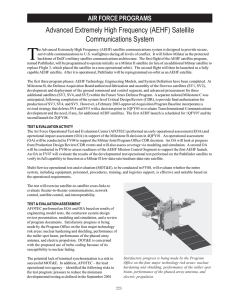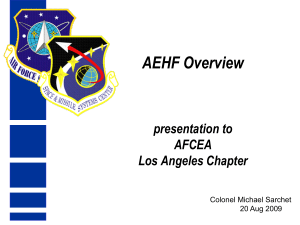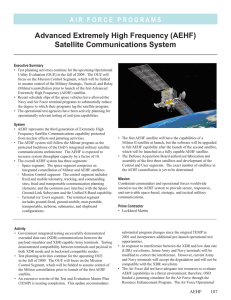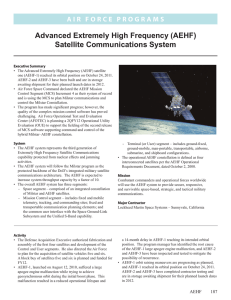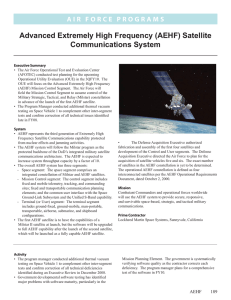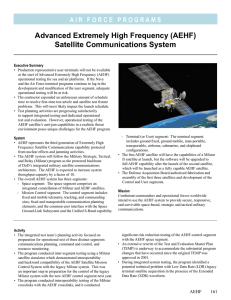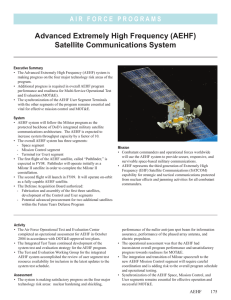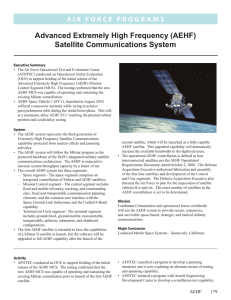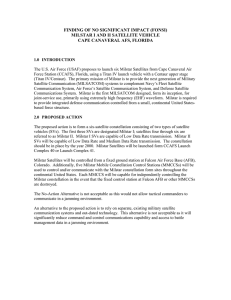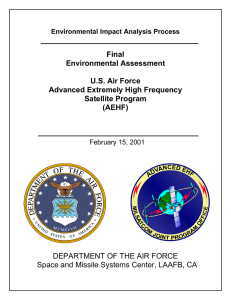FONSI FINDING OF NO SIGNIFICANT IMPACT ADVANCED EXTREMELY HIGH FREQUENCY SATELLITE Agency
advertisement
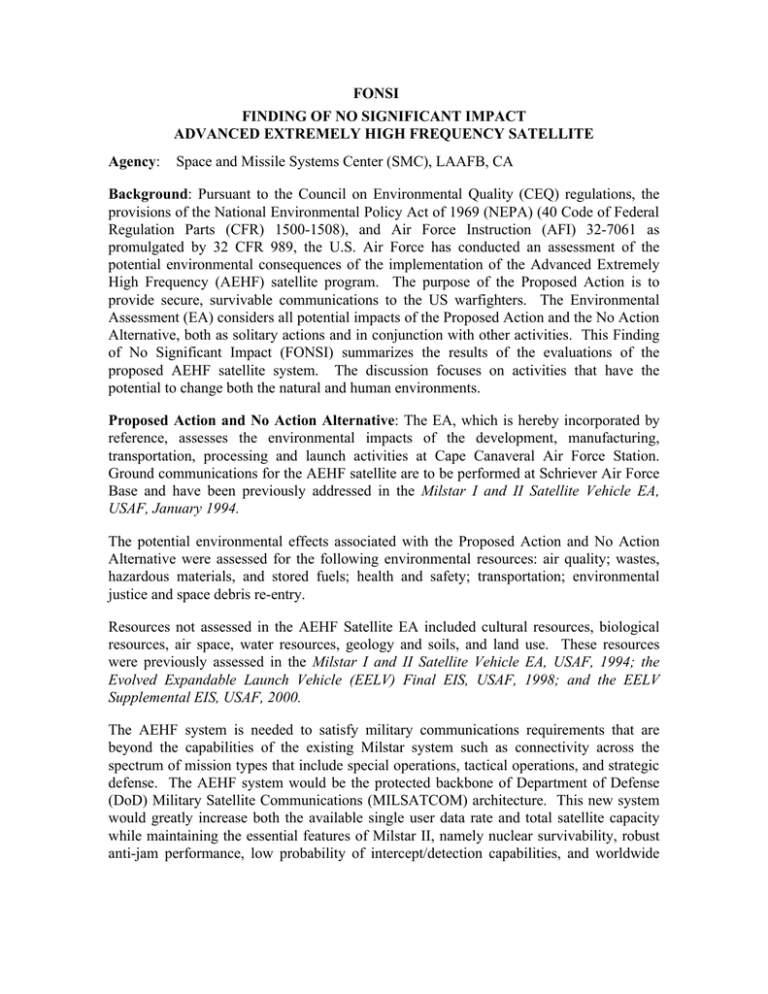
FONSI FINDING OF NO SIGNIFICANT IMPACT ADVANCED EXTREMELY HIGH FREQUENCY SATELLITE Agency: Space and Missile Systems Center (SMC), LAAFB, CA Background: Pursuant to the Council on Environmental Quality (CEQ) regulations, the provisions of the National Environmental Policy Act of 1969 (NEPA) (40 Code of Federal Regulation Parts (CFR) 1500-1508), and Air Force Instruction (AFI) 32-7061 as promulgated by 32 CFR 989, the U.S. Air Force has conducted an assessment of the potential environmental consequences of the implementation of the Advanced Extremely High Frequency (AEHF) satellite program. The purpose of the Proposed Action is to provide secure, survivable communications to the US warfighters. The Environmental Assessment (EA) considers all potential impacts of the Proposed Action and the No Action Alternative, both as solitary actions and in conjunction with other activities. This Finding of No Significant Impact (FONSI) summarizes the results of the evaluations of the proposed AEHF satellite system. The discussion focuses on activities that have the potential to change both the natural and human environments. Proposed Action and No Action Alternative: The EA, which is hereby incorporated by reference, assesses the environmental impacts of the development, manufacturing, transportation, processing and launch activities at Cape Canaveral Air Force Station. Ground communications for the AEHF satellite are to be performed at Schriever Air Force Base and have been previously addressed in the Milstar I and II Satellite Vehicle EA, USAF, January 1994. The potential environmental effects associated with the Proposed Action and No Action Alternative were assessed for the following environmental resources: air quality; wastes, hazardous materials, and stored fuels; health and safety; transportation; environmental justice and space debris re-entry. Resources not assessed in the AEHF Satellite EA included cultural resources, biological resources, air space, water resources, geology and soils, and land use. These resources were previously assessed in the Milstar I and II Satellite Vehicle EA, USAF, 1994; the Evolved Expandable Launch Vehicle (EELV) Final EIS, USAF, 1998; and the EELV Supplemental EIS, USAF, 2000. The AEHF system is needed to satisfy military communications requirements that are beyond the capabilities of the existing Milstar system such as connectivity across the spectrum of mission types that include special operations, tactical operations, and strategic defense. The AEHF system would be the protected backbone of Department of Defense (DoD) Military Satellite Communications (MILSATCOM) architecture. This new system would greatly increase both the available single user data rate and total satellite capacity while maintaining the essential features of Milstar II, namely nuclear survivability, robust anti-jam performance, low probability of intercept/detection capabilities, and worldwide access and interoperability. The AEHF system would provide essential, survivable, antijam communication services for the National Command Authorities (NCA) and Commanders in Chief (CINC) to command and control their strategic and tactical forces in all levels of conflict including nuclear war. Under the No Action Alternative, the Air Force would not go forward with the AEHF Satellite program. The warfighter and other users would continue to rely on the existing technology and capabilities of Milstar I and II which would be inadequate to meet future mission needs. Air Quality: Air emissions estimated for the processing, launch, and operation of the AEHF satellite would not adversely affect regional air quality. As long as the Florida Department of Environmental Protection (FDEP) permit operating parameters are adhered to, no significant ambient air quality impacts or exceedances are expected. Waste, Hazardous Materials, and Stored Fuels: Hazardous materials, wastes, and stored fuel will be managed in accordance with applicable Federal and State regulations, and installation guidelines. There is a potential for propellant spills or mishaps during processing, transfer, and launch operations. Any spills or mishaps will be handled pursuant to all applicable state and federal laws resulting in no significant impact to environment. However, no impacts from hazardous or solid wastes, hazardous materials, or stored fuels are anticipated to occur during the implementation of the preferred alternative. Health and Safety: Range Safety Requirements at CCAFS address all aspects of range safety, and establish the framework within which safety issues are addressed. With the use of these and other safety measures required by the 45th Space Wing, no adverse health and safety impacts are expected. Transportation Systems: There would be no permanent increase in traffic that would impact the installation transportation system. Impacts from the temporary increase of employees during launch operations would not result in significant impacts. Environmental Justice: The majority of the environmental impacts of the Proposed Action would occur within the boundary of the CCAFS and would not have an impact on low-income or minority populations. As the processing and launch of the AEHF satellite would occur only six times between 2004 and 2009, and would not constitute a disproportionate impact to low income or minority populations in Brevard County, there would be no environmental justice impacts associated with the Proposed Action. Space Debris Reentry: Orbital debris will be minimized through implementation of Air Force Space Command (AFSPACECOM) Regulation 57-2 (July 1991) requiring analysis, minimization, and mitigation of orbital debris. During launch and orbit, mitigation measures have been developed to minimize orbiting and deorbiting debris; therefore, no significant impacts are anticipated. Unavoidable Adverse Impacts: There are no adverse impacts associated with the implementation of the preferred alternative. Relationship Between Short-term Uses and Enhancement of Long-term Productivity: Implementation of the Proposed Action would have a positive effect on long-term productivity by providing the DoD with a secure, survivable communications system (SATCOM) to the US warfighters. Irreversible and Irretrievable Commitment of Resources: Under the Proposed Action, fuels, manpower, and costs related to transportation, processing, and operation of the AEHF satellite will be irreversibly lost. FINDING OF NO SIGNIFICANT IMPACT: Based upon my review of the facts and analyses contained in the attached Environmental Analysis, I conclude that implementation of the Proposed Action will not have a significant environmental impact, either by itself or cumulatively with other projects. Accordingly, the requirements of NEPA, the regulations promulgated by the Council on Environmental Quality and 32 CFR 989 are fulfilled and an Environmental Impact Statement (EIS) is not required. An availability notice for public review was published in the Daily Breeze, a local newspaper in Torrance, CA and in FLORIDA TODAY, a newspaper covering the State of Florida on February 27, 2001 for a 30 day review period which ended on March 29,2001. No comments were received. Copies of the EA and Draft FONSI were placed in the Public Library in El Segundo, CA and the Brevard County Library in Cocoa Beach, FL. The EA and FONSI also appeared on the Space and Missile Systems Center web site at http://ax.laafb.af.mil/axf/ and will be updated with the final document. A hard copy of the EA and FONSI will also be kept on file in the AEHF Program Office. The Point of Contact (POC) for requests for information is Mr.Theodore A. Krawczyk. He may be reached at (310 363-2419. The signing of this Finding of No Significant Impact (FONSI) completes the Air Force's Environmental Impact Analysis Process (EIAP). WILLIAM M. WILSON Brigadier General, USAF Vice Commander ———————————
